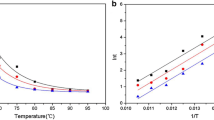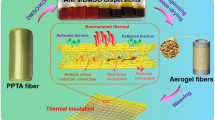Abstract
We report a new insulation composite of aramid honeycombs filled with superflexible resorcinol-formaldehyde aerogels. Aerogels produced via a sol-gel process were dried with supercritical C02. The aerogels exhibit a high, rubber-like flexibility, due to almost zero shrinkage and networking of nanoparticles and suitably sized macropores. The high porosity of the aerogels in the range of about 95-98% leads to a low thermal conductivity about 0.037 W/mK and low bulk density of 0.05 g/cm3. The filling of light and stiff aramid honeycombs with these flexible aerogels results in a composite with decreased thermal conductivity and modified mechanical properties.






Similar content being viewed by others
References
S.S. Kistler: Coherent expanded aerogels. J. Phys. Chem. 36, 52–46 (1932).
R. Pekala: Organic aerogels from the polycondensation of resorcinol with formaldehyde. J. Mater. Sci. 24, 3221–3227 (1989).
S. Mulik and Ch. Sotiriou-Leventis: Resorcinol - formaldehyde aerogels, in Aerogels Handbook, edited by M.A. Aegerter, N. Leventis and M.M. Koebel (Springer, New York, 2011), p. 215.
C. Jin: Aerogels super-thermal insulation materials by Nano Hi-tech, in Aerogels Handbook, edited by M.A. Aegerter, N. Leventis and M.M. Koebel (Springer, New York, 2011), p. 865.
R. Mendenhall: American Aerogel Corporation: organic aerogel commercialization, in Aerogels Handbook, edited by M.A. Aegerter, N. Leventis and M.M. Koebel (Springer, New York, 2011), p. 857.
L. Ratke and B. Milow: Aerogels for foundary applications, in Aerogels Handbook, edited by M.A. Aegerter, N. Leventis and M.M. Koebel (Springer, New York, 2011), p. 763.
J. Shen and D.Y. Guan: Preparation and application of carbon aerogels, In Aerogels Handbook, edited by M.A. Aegerter, N. Leventis and M.M. Koebel (Springer, New York, 2011), p. 813.
K. Kanamori, M. Aizawa, K. Nakanishi and T. Hanada: New transparent methylsilsesquioxane aerogels and xerogels with improved mechanical properties. Adv. Mater. 19, 1589–1593 (2007).
M. Schwan and L. Ratke: Flexibilisation of resorcinol formaldehyde aerogels. J. Mater. Chem. A 1, 13462–13468 (2013).
T. Bitzer: Honeycomb Technology (Chapman & Hall, London, 1997), p. 2.
L.J. Gibson and M.F. Ashby. Cellular Solids: Structure and Properties (Cambridge University Press, Cambridge, 1997), p. 175.
F.K. Abd El-Sayed, R. Jones and I.W. Burgess: Atheoretical approach to the deformation of honeycomb based composite materials. Composites 145, 341–360 (1997).
R.V. Beblo, J.P. Puttmann, N.E. DeLeon, J.J. Joo and G.W. Reich: SMP filled honeycombs as a reconfigurable skin: model and experimental validation, in Proc. of the 19th Int. Conf. on Composite Materials, Montreal, July-August, 2013, pp. 1, 9.
R. Jhaver and H. Tippur: Characterization and modeling of compression behavior of syntactic foam filled honeycombs. J. Reinf. Plast. Comp. 29, 3185–3196 (2010).
G. Murray, F. Gandhi and E. Hayden: Polymer filled honeycombs to achieve a structural material with appreciable damping. J. Intell. Mater. Syst. Struct. 23, 703–718 (2012).
C. Resewski and W. Buchgraber: Properties of new polyimide foams and polyimide filled honeycomb composites. Mater. Wiss. Werkstofftech. 34, 365–369 (2003).
S.C. Joshi: Low velocity impact performance of aerogel filled sandwich composites, in Proc. of the 16th Int. Conf. on Composite Structures, Porto, June, 2011.
http://www.aerogel.com/ (accessed April 25, 2014).
http://glassmagazine.com/article/commercial/most-innovative-energy-e_cient-glass-product-106654 (accessed April 25, 2014).
A. Knop and L.A. Pilato: Phenolic Resins (Springer-Verlag, Berlin, Heidelberg, New York, Tokyo, 1985), p. 175.
HexWeb™ honeycomb attributes and properties. Hexcel, 1999.
Kevlar Aramid Fiber, Technical Guide, Table 11-1, DuPont Advanced Fiber Systems, Richmond, VA, USA.
Author information
Authors and Affiliations
Corresponding author
Rights and permissions
About this article
Cite this article
Schwan, M., Milow, B. & Ratke, L. Novel superflexible resorcinol-formaldehyde aerogels and combining of them with aramid honeycombs. MRS Communications 4, 177–181 (2014). https://doi.org/10.1557/mrc.2014.31
Received:
Accepted:
Published:
Issue Date:
DOI: https://doi.org/10.1557/mrc.2014.31




